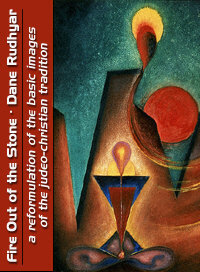 |
| Home | Bio | Art | Music | Literature | Civilization & Culture | Philosophy of Wholeness | Theosophy & Spirituality | Astrology |

FIRE OUT OF THE STONE A Reformulation of the Basic Images of the Judeo-Christian Tradition by Dane Rudhyar, 1962 1. Not to Repeat, But to Renew 2. The Essence and the Substance 3. To Become "More-Than-Man" 4. The Fatherhood of God 5. At the Center is Soul 6. Creation and Evolution 7. Crisis and Sin 8. The Coming-Together of God and Man • Page 1 • Page 2 • Page 3 • Page 4 • Page 5 9. Christ-Love: The Covenant with Individual 10. The Life of Mediation and its Paradox
: : :
This title was first published by Sevire, 1963. Cover for the online edition copyright © 2008 by Michael R. Meyer. : : : : : :
"Thy God is a cosumming fire." Duet. 4:25 "He shall baptize you with the Holy Spirit and with fire." Matthew 3:11 "I am come to send fire on the earth." Luke 12:49
: : :
|

8. THE COMING-TOGETHER OF GOD AND MAN - page 1
"God becomes as we are, so that we may be as He is."
William Blake — There is no Natural Religion; 1788 It is probably no exaggeration to say that there is no word more important in the whole Bible than the term "Covenant". This term literally means a "coming together"; it indicates a meeting, an actualized relationship. What gives to the Biblical tradition its most characteristic feature, by comparison with other bodies of religious doctrines or myths, is that the whole picture of human evolution which the Bible presents rests upon the development of the relationship between God and man. God, as Jehovah-Yahweh, is the positive, creative pole of the relationship; man is the receptive, unstable and often truly negative pole. But the important fact is that everything the Bible records can be seen as one phase or another in the process of unfoldment of the God-man relationship. The successive covenants by which this relationship is given a progressive form and character mark the essential turning-points in this process. Obviously if one believes in a definite and evolving relationship between God and man God must be endowed with at least some of the attributes of personality. When God is conceived as a metaphysical abstract Principle, or even as a vast cosmic Existence within which all there is acts and struggles, there can hardly be any real relationship between such a God and man; there certainly can be no relation of mutuality, no interaction between them — and this is the case in Hindu or Chinese metaphysical-cosmic doctrines. It is true that the Hindu will say that the divine-cosmic Brahman is "one with" the human atman; but this identification provides no basis for "relationship". Relationship implies the fact that the related factors, while sharing some common foundation, are different from or perhaps opposite to each other. If all there is is God-Brahman, then man is essentially illusory or, at best, a fragmentary and superficial phenomenon fulfilling no really basic place in the cosmic "dream" or "play" of God. If so, there can be no significant relationship, no mutual interaction or interpenetration between an absolute Reality and a fleeting illusion born (somehow!) of "ignorance". The Hebraic tradition however presents us with the picture of a God Who communicates with man, Who is angered or delighted by man's responses, and to Whom man should pray; and this tradition finds its logical consummation in the person of Jesus Christ in whom the divine and human natures are not only united, but interpenetrate as in a kind of symbolical marriage. Indeed all the Near-Eastern religions, in one form or another, stress this personal communication of God with man, and man with God; and when man is seen having reached a stage of total devotion to and love of God, God becomes "the Beloved", the constant Partner, the immanent and glowing Presence, an all-inclusive "Thou" to every human "I" (cf. Martin Buber's "I and Thou", a remarkable instance of Jewish mysticism). We even hear great Christian teachers, like Meister Eckhardt, emphatically say that "God needs me, as I need Him". This is total relationship, a complete realization of mutuality in an everlasting and indeed quasi-absolute "coming together". It is evident, however, that such a state of mystical union-in-sharing cannot be experienced during the early stages of the soul's evolution. The instinctive and utterly spontaneous reliance of the as yet pure and non-individualized "living soul" upon the divine Source, of which it is only a reflection, is not a true relationship, any more than the reflection in a mirror is in a condition of relationship to the real face — it is simply a projection of the face without any independent characteristics. You can only be truly related to someone to whom you could refuse to be related. The mutuality of response between the participants in any true relationship is vitalized by the possibility that the relationship might, at any moment, be dissolved or at least transformed. Indeed a relationship is usually strengthened by the fact that there are outside pressures which tend to dissolve it — a fact which defines, as it were, its meaning and value. In order that the purely reflective "living soul" may begin to experience the gradual process of individualization, some kind of crisis is necessary. There are two fundamental possibilities: (1) the "reflection" meets another "reflection" and a sense of contrast develops which may lead to a real sharing. Thus Adam meets Eve, and one might theoretically assume that the Adam-Eve relationship could have "differentiated" both of them without upsetting their sense of reliance upon their divine Source, God; but the Bible tells us that what happened instead was — (2) that the "reflection" sought to assert its desire-to-be against its Source in the symbolical way of "disobedience". In Gen. 3 : 5 the serpent promises: "Your eyes shall be opened and ye shall be as gods, knowing good and evil" — in other words, experiencing duality, which means the capacity to become separated from the divine Source; to become "dereflectionized", i.e., to jump out of the mirror (the Garden of Eden) and acquire a positive character. This however makes "tragedy" inevitable. Adam and Eve found themselves not only "naked", i.e., having to face the conflicts, the vulnerability and doubts implied in the very basic relationship of man to woman; they found themselves also impelled to project these unresolved conflicts upon their children, Cain and Abel. From these children, as we saw, two lines of human development proceeded: the way of the city through the use of fire and metals (civilization), and the way of nomadic cattle-raising and multiplication of seeds (culture). The first line (the Cain line) stressed interhuman relationships and presumably left out of the picture the relationship of man to God. If it was kept in mind at all, it was on an intellectual or purely symbolic level. The second line (the Seth line) kept man's relationship to God as the basic and vital fact of its pastoral life. It is this line which God naturally "favored". These men "walked with God" as they moved along with their flocks or slept under the stars. When the "coming of the sons of God" (the Ben-Elohim; Gen. 6 : 1-2) introduced a new and infinitely disturbing creative factor into human evolution, we can assume that both lines were affected by this great release of new spiritual potentiality, though the Genesis story here is very sketchy and vague. At any rate, when the most basic life-relationships became affected by the negative reactions of mankind to the conscious use of creative power, when sex-perversions and "black magic" led to an ever-increasing state of psychic darkness and evil-intoxicated imagination, God could still find among the Seth line a Noah and his family to "seed" the future of mankind after the Deluge catharsis. By then man was no longer a mere reflection of God; he was in potentiality a "son of God". He had received the Promethean gift, the "God-seed". Because of this the meeting of God and man could develop into a real relationship — a relationship made possible by Noah's faith in God's voice and presence, and by his capacity to adapt himself "creatively" to an unprecedented situation. Noah is, because of this, the prototype of a new type of human being, of a new phase of soul development. Such a new human type can relate himself to God in a new way; and the new relationship becomes sealed, as it were, and symbolized by a "covenant". When this occurs God and man have really begun to "come together".  Home | About | Calendar | Ephemeris Charts | Art Gallery | Library | Resources Shop | Rudhyar Archival Project | Help Web design and all data, text and graphics appearing on this site are protected by US and International Copyright and are not to be reproduced, distributed, circulated, offered for sale, or given away, in any form, by any means, electronic or conventional. See Notices for full copyright statement and conditions of use. Web design copyright © 2000-2004 by Michael R. Meyer. All Rights Reserved. |